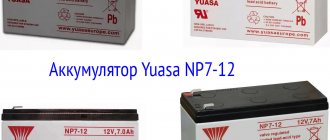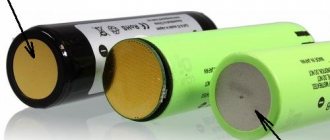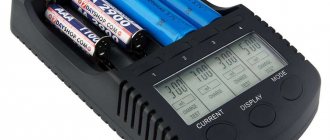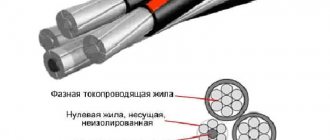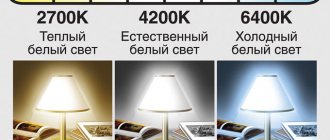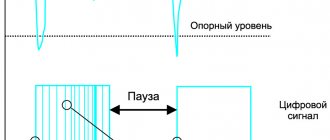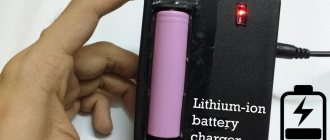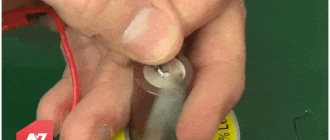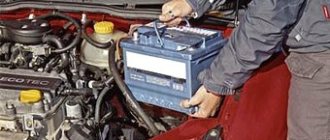Polarity of 18650 battery Li-ion batteries 18650, 14500, etc. They look very similar to a AA battery.
For a lithium-ion battery, everything is the same, only the protrusion (positive contact) is slightly wider in diameter than in a battery. There are also small holes around the positive contact of the battery. The negative pole is as flat as in a battery.
In general, if you see holes around the pole, it is 100% positive, plus, (+).
In this case, we consider a lithium-ion battery without protection. The protected battery bank looks exactly the same, only it will be longer in length by the thickness of the protection board.
In addition, like most batteries, lithium ions have indications on the case where there is a plus and a minus.
A multimeter or tester (digital voltmeter) will also help determine the polarity. When measuring voltage, bringing the red probe to the positive contact and the black probe to the negative, the voltage in the bank will appear on the screen. If the red probe is brought to the negative contact, “-” (minus) will appear on the screen in front of the voltage value.
The li ion 18650 battery is a cylindrical battery. It is not much different from ordinary AA “finger” batteries, but they are larger in size. They are 66 mm long and 18 mm in diameter.
Types and types of Li Ion 18650 batteries
All 18650 batteries can be divided into types based on cathode material. The main operational characteristics of batteries depend on this component: capacity and possible discharge current.
The most common are lithium-cobalt batteries. They differ from other batteries in their large capacity. Therefore, they can be used longer.
There is also a group of lithium-manganese batteries. Compared to lithium-cobalt batteries, they have a lower capacity, but at the same time have a higher discharge current.
The last group is lithium ferrophosphate batteries. Although they do not have a large capacity or high voltage, they can be operated for more than 1000 cycles. In addition, until fully charged, you need to keep the batteries in the station for 1 hour.
What happens if you reverse the polarity of a car battery?
If you reverse the polarity of the battery, you will not be able to avoid serious consequences: complex car repairs or even its loss as a result of a fire. Let's consider different situations.
When charging the battery
What are the consequences of confusion with battery polarity? There are two possible scenarios here:
- With a probability of up to 99%, it can be said that the charger will definitely fail if charging was carried out at home using cheap equipment. In such a situation, it is not difficult to mix up the terminals, because the charging “crocodiles” are usually the same size.
- If a professional charger is used, then when the battery is fully charged, its polarity will be reversed, that is, the terminal corresponding to “+” will become negative and vice versa. Under no circumstances should a battery charged in this way be installed on a car - this is the same as swapping the terminals when installing it, the consequences will be similar.
What to do? How to return the battery to its original factory polarity? Discharge it completely without installing it on a vehicle, and then charge it again, but strictly observing the established polarity.
If, when installing the battery for charging, it was almost immediately discovered that the polarity of the current terminals is broken, then you should immediately, having first disconnected the charger, change it to the one that corresponds to reality and continue the process.
When installed on a vehicle
Please note that the niche reserved for the battery in the engine compartment has not only a certain size, but also a configuration. This means that equipment can be placed there only in one strictly defined way.
In addition, the conductors that serve to connect to the terminals also have a specific set length. Consequently, if you mistakenly purchase a straight-polarity battery instead of a reverse-polarity device provided for by the car design, the difference between which is the location of the positive terminal, then you will not be able to install it correctly while observing the polarity of the current terminals when connecting.
If the terminals are swapped, then when the engine starts, all electronics and devices connected to the on-board network will fail.
However, if the motor is not working, only those devices that were connected to the network will be unsuitable for further use.
A battery with reversed polarity during installation and left in this position for a long time can cause a short circuit, which, in turn, can cause a vehicle fire.
18650 batteries with protection
Safety requirements for the operation of lithium-ion batteries state that the voltage inside the batteries must be in the range of 2.5-4.2 volts. It is very difficult to control this parameter on your own, so a board with protection was invented specifically for this. This element prevents the voltage from going beyond the specified range.
Manufacturers solder this board to the pins using steel or aluminum tape. Large nutrient factories rarely produce such protections. The devices for which they are manufactured have charge-discharge controllers. These are batteries for laptops, screwdrivers and other complex units.
Most of the protected 18650 lithium-ion batteries are produced by Chinese manufacturers. A protective board is soldered onto an unprotected battery and wrapped in a special thermal protective material. Their length, due to the use of the board, increases by several millimeters.
It is better to equip all devices that do not have an element for monitoring the battery status with protected batteries. Otherwise, they may fail, discharge to zero or explode. In this case, the protection will not be able to prevent the battery from overheating. It controls the state of tension.
How the marking is deciphered
As an example, consider the ICR18650-26F M lithium-ion battery.
- The first symbol “I” is used on all elements of this type that are created using the same technology;
- The second letter allows you to understand what material the cathode is made of. For lithium-ion batteries, this can be cobalt - C, manganese - M, iron phosphate - F;
- The next letter – R – stands for battery;
- The 18650 numbers can be divided into two blocks: 18 and 65. These are the length and diameter, respectively;
- The last digit 0 is the shape, that is, the cylinder.
At the same time, the markings of different manufacturers may vary greatly.
Which terminal is thicker, plus or minus?
As a rule, the positive terminal is different in size from the negative terminal. You can see with the naked eye that one of the terminals is “thicker”, so it is positive.
Interesting materials:
What should I do if the touchpad does not appear in Device Manager? What to do if you don't receive SMS? What to do if your friends are jealous of you? What to do if you are accused of shoplifting? What to do if you are blocked on YouTube? What to do if the biscuit dough turns out thick? What to do if the fabric is stuck to the iron? What to do if foundation emphasizes peeling? What to do if there is a crack in your nail? What to do if the central processor is loaded at 100?
General characteristics of 18650
| Capacity (mAh) | Output voltage (V) | Maximum current (A) | Protection board |
| 1100 | 3.3 | +/- | |
| 1300 | 3.6 | 18 | +/- |
| 1620 | 3,6-3,7 | 20 | +/- |
| 2000 | 3,6-3,7 | 20-30 | +/- |
| 2100 | 3,6-3,7 | 20-30 | +/- |
| 2200 | 3,6-3,7 | 20-30 | +/- |
| 2400 | 3,6-3,7 | 20-30 | +/- |
| 2500 | 3,6-3,7 | 20-35 | +/- |
| 2600 | 3,6-3,7 | 20-35 | +/- |
| 2800 | 3,6-3,7 | 20-35 | +/- |
| 3000 | 3,6-3,7 | 20-35 | +/- |
| 3100 | 3,6-3,7 | 20-35 | +/- |
| 3200 | 3,6-3,7 | 20-35 | +/- |
| 3350 | 3,6-3,7 | 20-35 | +/- |
| 3400 | 3,6-3,7 | 20-35 | +/- |
| 3500 | 3,6-3,7 | 20-35 | +/- |
| 3600 | 3,6-3,7 | 20-35 | +/- |
The table shows the most popular batteries.
Dimensions with protection: 66.5*18 mm and 66*18 mm without protection. Weight on average about 40 grams.
Main manufacturers: Samsung, Fenix, Avant, LG, Panasonic, Olight, Camelion, Proconnect, Rombica, SANYO and SONY.
How to choose the right 18650 battery for yourself
Lithium-ion batteries differ from each other in several characteristics. Because of this, it is necessary to pay attention to their type and technical characteristics before making a purchase.
When choosing a li ion 18650 battery, you need to pay attention to the following characteristics:
- Energy intensity;
- Rated current;
- Voltage
- Tendency to overheat.
If you need to purchase batteries with greater autonomy, then you need to pay attention to the capacity, which is measured in mAh. But, the higher the capacitance indicator, the lower the current will be. Therefore, by sacrificing one, you can gain another. In simple terms, the current strength affects the tendency of the battery to overheat.
The battery voltage depends on the charge. Voltage can be nominal, minimum, maximum and real. The manufacturer indicates the initial voltage on the packaging. It is important that its value does not fall below 2.4 Volts, otherwise the battery will be extremely difficult to revive. If you use batteries that do not withstand high temperatures well, you may experience an explosion.
Battery rating based on operating experience
Battery connection diagrams
You can purchase cases for batteries, with the help of which several elements are combined into one large one. If you connect several of these batteries using cases in parallel, the capacity will increase by as much as the number of batteries that are connected 3600*3=10800 mAh. In this case, the voltage will be equal to the voltage of one battery. The duration of their use depends on the capacity.
Parallel connection of 18650 batteries
They can be connected in series. In this case, the voltage will add up, and the capacity will remain equal to one battery. This can be done using a special case. By connecting 3 3.7 V batteries we get an 11.1 volt 3600 mAh battery.
Series connection of 18650 batteries
How to check battery capacity
There are several effective ways to find out the capacity of any battery. Some of them do not require special expenses or special equipment, but only simple mathematical calculations.
The accuracy of such methods is not as high as when using special devices, but they allow you to find out the approximate capacity. For many this will be enough.
So, to calculate the capacitance using the free method, you need to use a known current. The battery specifications contain information about the current. A battery with a capacity of 3600 is charged for 36 hours with a current of 100 mAh. This means that the final result is obtained by multiplying two components: time and current. Therefore, knowing how much is required for a full charge, you can find out the capacity.
To measure capacity in another way, you will need to spend money. There are many smart chargers that can quickly measure capacity. They can be purchased at a specialty store or on aliexpress. They are used to measure various indicators, not just capacity.
Which side should you insert the battery into the charger?
Which side should the battery be inserted in? It must be installed so that the plus of the battery cannot touch or contact the minus of the atomizer itself. Therefore, if you know and remember this only rule, installing batteries in a mechanical mod will not be a problem even for novice users.
Interesting materials:
How to order 20 UAH on MTS? How to order additional 2000 MB on Kyivstar? How to order food from KFC? How to order a product with a 50% discount from Oriflame? How to order a police clearance certificate in Moldova? How to order a traffic light in a store? How to seal a cracked sole on sneakers? How to finish 11th grade with a red certificate? How to legally use someone else's content? How to color cells according to a condition?
How to charge and with what current
Lithium-ion cells can be charged at various stations. The main thing is that the voltage value is 5 V, and the current is from 0.5 to 1 of the nominal battery capacity. The lithium cell, which has a capacity of 2600 mAh, is charged with a current of 1.3 to 2.6 amperes.
The entire charging period can be divided into several stages. First, the unit, using a current of 0.2 of the capacity, charges for an hour. In this case, the voltage value varies between 4.1-4.2 volts. Then the tension increases.
In order not to bother yourself, you should just buy a charger for AA batteries.
How to restore a 18650 battery
An 18650 battery can only be restored if it is not completely discharged. Sometimes it is difficult to revive a battery that is not completely discharged. But there is one far from well-known option with disabling the board.
It is done like this:
- The protection in the form of a board is removed.
- The tester measures the voltage at the outputs. Its value should be in the range 2 -2.5 V.
- Using a charger with current regulation, you need to connect it to the battery, setting it to 100 mA and 4.2V.
If the battery starts charging, it means it is still alive and can be restored.
Still have questions about 18650 Batteries or have something to add? Then write to us about it in the comments, this will make the material more useful, complete and accurate.
Lithium-ion batteries of size 18650 have almost overtaken conventional AA batteries in popularity. They power a variety of devices, from electronic cigarettes to electric vehicles. They are more dangerous: if the lithium power supply is not installed correctly in the device, it can explode. Therefore, you need to know where the plus and minus of 18650 are, and in what ways you can find the poles.
Instructions for the first battery charge
Against the background of all the versions listed above, you can use the general instructions on how to charge a new phone and how many times this needs to be done for proper calibration. After purchasing a mobile device, you need to turn it on immediately and completely discharge it to zero. Then the gadget is put on charge, and the battery is filled with 100 percent energy. In this case, the phone itself must be turned off.
Once fully charged, the phone is activated and the entire procedure is repeated again. Complete discharge and then filling. This calibration must be repeated at least three times, and preferably 5 times. This will help maintain the functionality of the battery for a longer time. If the seller does not provide a method for charging the battery for the first time, use general recommendations.
If you still have doubts about how to properly charge the battery, you can ask the seller about this when purchasing a mobile device. Smartphones should also come with instructions that indicate the type of battery, how to charge correctly, and how many times “pumping” is performed.
There is no need to calibrate the new charger. However, in this case, after a few months of operation, you may need a new battery for your phone. If you do not carry out the initial calibration, the risk increases that after 100-150 days the device will only work when plugged into the network.
Methods for determining polarity
Since externally 18650 batteries are very similar to AA cells and the like, you can determine the polarity of the power source in the same way as in the case of a AA battery. There are two main ways to find plus and minus: by external inspection of the element or using any instrument that can measure the voltage at the poles.
By the appearance of the battery
The easiest way to determine the polarity of 18650 is to study the markings on the body of the product. On the sticker you can see all the necessary information, including:
- battery size;
- name of the manufacturing company;
- capacity in mAh;
- Rated voltage.
On high-quality elements, the polarity must be indicated - “plus” at one end and “minus” at the other. If there is no suspicion of erroneous labeling, you can safely rely on these icons. However, unscrupulous companies may not place polarity marks on their products. It is also possible to allow defective products to be sold - batteries on the housings of which the sticker is affixed on the wrong side, which is why the pole signs are reversed.
If you purchased a power source from an unknown manufacturer, you should additionally inspect its contact pads directly. Ideally, you should always do this to ensure maximum operating safety for 18650 batteries.
Like salt or alkaline batteries, the contacts of lithium-ion batteries differ in shape: the negative terminal is flat, while the “plus” terminal is convex. Additionally, lithium batteries typically have multiple holes on the positive terminal. They are needed to release the gas generated when the power source heats up. Thanks to this design, polarity can be determined not only by inspection, but also by touch.
Differences between positive and negative terminals
First, it is advisable to understand the structure of the battery, the most common type of which is lead-acid. It is a plastic box divided into 6 sections, each of which is a separate battery. Each section contains a package of plates with alternating polarity. Lead dioxide is applied to the plates with a positive charge. Sponge lead is used for those having a negative charge.
The terminals can be distinguished by their appearance; European ones are cylindrical in shape, that is, they have a round cross-section. Asian ones are divided into two varieties; they can be round or flat. If flat ones are used instead of round ones, they are often threaded. The difference in size is also observed: in European ones the minus diameter is 17.9 mm, and in Asian ones it is 11.1. The positive contact in European cars has a diameter of 19.5 mm, in Asian cars - 12.7.
If a battery with a different polarity is installed, the contacts are not connected due to the difference in diameter. Connection is only possible through a special adapter. Another difference between the two types is that in European-type batteries, the terminals are hidden in niches, so they do not stand out on the body. In Asian ones, they rise above the lid and, when installed on another car, can even rest against the hood. The main differences between terminals with different charges are shown in the table:
| Main Differences Between Positive and Negative Terminals | ||
| Plus | Minus | |
| Location | Direct polarity or “Asia” is the terminal on the left, reverse polarity or “Europe” is on the right. | Forward polarity is the terminal on the right, reverse polarity is on the left. |
| Size | "Asia" - 17.5 mm, "Europe" - 19.5 mm. | "Asia" - 11.1 mm, "Europe" - 17.9 mm. |
| Color of cap or identification ring | Red | Blue, grey, black or silver. |
| Form | They have the same shape - cylindrical; in Asian batteries they can be flat. | |
| Height | They do not differ in height; in “Europe” type batteries they are located in niches on the lid, in “Asia” type batteries they rise above the lid. |
Read also: Helicopter concrete grinding machine
